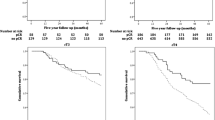Abstract
Background
Neoadjuvant chemotherapy (NAC) is commonly used to treat locally advanced breast cancer. Pathologic complete response (pCR) predicts improved overall survival (OS); however, prognosis of patients with partial response remains unclear. We evaluated whether tumor response ratio (TRR) is a better predictor of OS than current staging methods.
Methods
Using the National Comprehensive Cancer Network Breast Cancer Outcomes Database, we identified patients with stage I–III breast cancer who had NAC and pretreatment imaging at City of Hope (1997–2010). Patient demographics, tumor characteristics, and OS were analyzed. TRR was calculated as residual in-breast disease divided by size on pre-NAC imaging. Four TRR groups were stratified; TRR 0 (pCR), TRR > 0–0.4 (strong partial response, SPR), TRR > 0.4–1.0 (weak partial response, WPR), or TRR > 1.0 (tumor growth, TG). OS was estimated by the Kaplan–Meier method and tested by the log-rank test. Cox regression was performed to evaluate associations between OS and TRR in a multivariable analysis while controlling for potential confounders.
Results
There were 218 eligible patients identified; 59 (27 %) had pCR, 61 (28 %) SPR, 72 (33 %) WPR, and 26 (12 %) TG. Five-year OS decreased continuously with increasing TRR:pCR (90 %), SPR (79 %), WPR (66 %), and TG (60 %). TRR was the only measure that significantly predicted OS (p = 0.0035); pathologic stage (p = 0.23) and pre-NAC clinical tumor stage (cT) (p = 0.87) were not significant. TRR continued to be statistically significant by multivariable analysis (p = 0.016).
Conclusions
TRR takes into account both pretreatment and residual disease and more accurately predicts OS than pathologic stage and pre-NAC cT. TRR may be useful to more accurately assess prognosis and OS in breast cancer patients undergoing NAC.



Similar content being viewed by others
References
Kaufmann M, von Minckwitz G, Bear HD, et al. Recommendations from an international expert panel on the use of neoadjuvant (primary) systemic treatment of operable breast cancer: new perspectives, 2006. Ann Oncol. 2007;18:1927–34.
Edge SB, Compton CC, Fritz AG, et al. American Joint Committee on Cancer (AJCC) cancer staging manual. 7th ed. Chicago: Springer; 2010.
Kuerer HM, Newman LA, Smith TL, et al. Clinical course of breast cancer patients with complete pathologic primary tumor and axillary lymph node response to doxorubicin-based neoadjuvant chemotherapy. J Clin Oncol. 1999;17:460–9.
Symmans WF, Peintinger F, Hatzis C, et al. Measurement of residual breast cancer burden to predict survival after neoadjuvant chemotherapy. J Clin Oncol. 2007;25:4414–22.
Jeruss JS, Mittendorf EA, Tucker SL, et al. Staging of breast cancer in the neoadjuvant setting. Cancer Res. 2008;68:6477–81.
Weeks JC. Outcomes assessment in the NCCN. Oncology (Williston Park). 1997;11(11A):137–40.
Weeks J. Outcomes assessment in the NCCN: 1998 update. Oncology (Williston Park). 1999;13(5A):69–71.
Niland JC. NCCN outcomes research database: data collection via the Intranet. Oncology (Williston Park). 2000;14(11A):100–3.
von Minckwitz G, Untch M, Blohmer JU, et al. Definition and impact of pathologic complete response on prognosis after neoadjuvant chemotherapy in various intrinsic breast cancer subtypes. J Clin Oncol. 2012;30:1796–804.
Chollet P, Amat S, Cure H, et al. Prognostic significance of a complete pathological response after induction chemotherapy in operable breast cancer. Br J Cancer. 2002;86:1041–6.
Bear HD, Anderson S, Brown A, et al. The effect on tumor response of adding sequential preoperative docetaxel to preoperative doxorubicin and cyclophosphamide: preliminary results from National Surgical Adjuvant Breast and Bowel Project Protocol B-27. J Clin Oncol. 2003;21:4165–74.
Bonadonna G, Valagussa P, Brambilla C, et al. Primary chemotherapy in operable breast cancer: eight-year experience at the Milan Cancer Institute. J Clin Oncol. 1998;16:93–100.
Wolmark N, Wang J, Mamounas E, Bryant J, Fisher B. Preoperative chemotherapy in patients with operable breast cancer: nine-year results from National Surgical Adjuvant Breast and Bowel Project B-18. J Natl Cancer Inst Monogr. 2001;30:96–102.
Green MC, Buzdar AU, Smith T, et al. Weekly paclitaxel improves pathologic complete remission in operable breast cancer when compared with paclitaxel once every 3 weeks. J Clin Oncol. 2005;23:5983–92.
Baselga J, Bradbury I, Eidtmann H, et al. Lapatinib with trastuzumab for HER2-positive early breast cancer (NeoALTTO): a randomised, open-label, multicentre, phase 3 trial. Lancet. 2012;379(9816):633–40 (Erratum in: Lancet. 2012;379(9816):616).
Steger GG, Greil R, Lang A, et al. Epirubicin and docetaxel with or without capecitabine as neoadjuvant treatment for early breast cancer: final results of a randomized phase III study (ABCSG-24). Ann Oncol. 2014;25:366–71.
von Minckwitz G, Rezai M, Loibl S, et al. Capecitabine in addition to anthracycline- and taxane-based neoadjuvant treatment in patients with primary breast cancer: phase III GeparQuattro study. J Clin Oncol. 2010;28:2015–23.
Ogston KN, Miller ID, Payne S, et al. A new histological grading system to assess response of breast cancers to primary chemotherapy: prognostic significance and survival. Breast. 2003;12:320–7.
Sataloff DM, Mason BA, Prestipino AJ, Seinige UL, Lieber CP, Baloch Z. Pathologic response to induction chemotherapy in locally advanced carcinoma of the breast: a determinant of outcome. J Am Coll Surg. 1995;180:297–306.
Corben AD, Abi-Raad R, Popa I, et al. Pathologic response and long-term follow-up in breast cancer patients treated with neoadjuvant chemotherapy: a comparison between classifications and their practical application. Arch Pathol Lab Med. 2013;137:1074–82.
von Minckwitz G, Schmitt WD, Loibl S, et al. Ki67 measured after neoadjuvant chemotherapy for primary breast cancer. Clin Cancer Res. 2013;19:4521–31.
Varga Z, Diebold J, Dommann-Scherrer C, et al. How reliable is Ki-67 immunohistochemistry in grade 2 breast carcinomas? A QA study of the Swiss Working Group of Breast- and Gynecopathologists. PLoS One. 2012;7:e37379.
Early Breast Cancer Trialists’ Collaborative Group (EBCTCG). Effects of chemotherapy and hormonal therapy for early breast cancer on recurrence and 15-year survival: an overview of the randomised trials. Lancet. 2005;365(9472):1687–717.
Acknowledgment
The authors thank Nicola Solomon, PhD, for editorial assistance.
Disclosure
The authors declare no conflict of interest.
Author information
Authors and Affiliations
Corresponding author
Rights and permissions
About this article
Cite this article
Miller, M., Ottesen, R.A., Niland, J.C. et al. Tumor Response Ratio Predicts Overall Survival in Breast Cancer Patients Treated with Neoadjuvant Chemotherapy. Ann Surg Oncol 21, 3317–3323 (2014). https://doi.org/10.1245/s10434-014-3922-0
Received:
Published:
Issue Date:
DOI: https://doi.org/10.1245/s10434-014-3922-0




